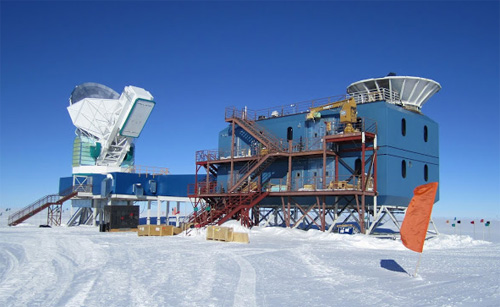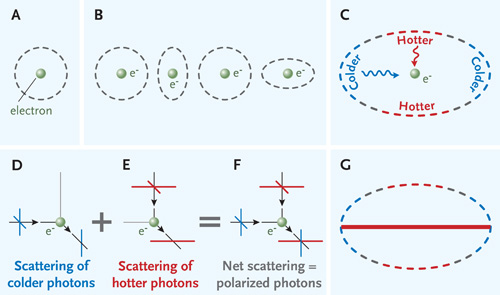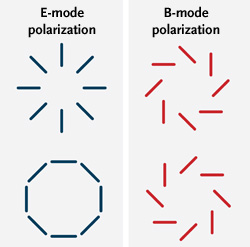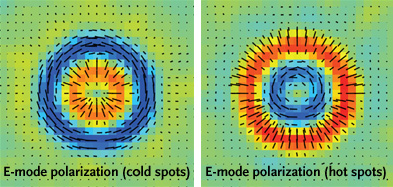UPDATE MARCH 17: All the rumors were true. The story below was written yesterday, before today's announcement that the fingerprints of inflation have been found in the cosmic microwave background. Read the full account of today's announcement here.

Cosmic searches at the South Pole. The BICEP-2 Telescope is inside the up-facing dish-shaped shield at right. The larger white dish is the South Pole Telescope (SPT), and the building is the Dark Sector Laboratory. Both experiments observe in the millimeter-submillimeter part of the spectrum, mapping polarization patterns in the cosmic background radiation.
BICEP-2 Project
MARCH 16: Rumors have been racing through the physics and cosmology communities for the last few days that long-sought evidence for cosmic inflation driving the Big Bang will be announced on Monday, March 17th. A press conference for a "major discovery" regarding this topic is scheduled for noon EDT (16:00 UT) at the Harvard-Smithsonian Center for Astrophysics, just up the street from Sky & Telescope. We'll be there.
Word of what may be announced first broke into wide circulation Friday night, when The Guardian newspaper in the U.K. published an article online, Gravitational waves: Have US scientists heard echoes of the big bang? Here are excerpts:
There is intense speculation among cosmologists that a US team is on the verge of confirming they have detected "primordial gravitational waves" — an echo of the big bang in which the universe came into existence 14bn years ago … that would change the face of cosmology and particle physics.
"If they do announce primordial gravitational waves on Monday, I will take a huge amount of convincing," said Hiranya Peiris, a cosmologist from University College London. "But if they do have a robust detection … Jesus, wow! I'll be taking next week off."
The discovery of gravitational waves from the big bang would offer scientists their first glimpse of how the universe was born.
The signal is rumoured to have been found by a specialised telescope called Bicep (Background Imaging of Cosmic Extragalactic Polarization) at the south pole. It scans the sky at microwave frequencies, where it picks up the fossil energy from the big bang.
For decades, cosmologists have thought that the signature of primordial gravitational waves could be imprinted on this radiation. "It's been called the Holy Grail of cosmology," says Peiris, "It would be a real major, major, major discovery.… The primordial gravitational waves have long been thought to be the smoking gun of inflation. It's as close to a proof of that theory as you are going to get." This is because cosmologists believe only inflation can amplify the primordial gravitational waves into a detectable signal…
"This is the real big tick-box that we have been waiting for. It will tell us something incredibly fundamental about what was happening when the universe was 10–34 seconds old," said Prof Andrew Jaffe, a cosmologist from Imperial College, London, who works on another telescope involved in the search called Polarbear…
In last October's Sky & Telescope we published an article on the race among several projects to find inflationary B-modes, and how this subtle signal would be formed within the first 10–34 second of time zero. Here it is for background: Back to the Big Bang by Bruce Liebermann (2 MB pdf file). Here is our list of B-mode search projects, with links to all of them.
And here's an explanation of how gravitational waves create the polarization patterns that researchers are trying to detect:

Gravitational waves created polarization patterns in the cosmic microwave background (CMB) by stretching and squeezing space — and therefore the plasma soup of primordial photons and electrons — as the waves passed through. (A) Before a wave hits it from behind, a cross-section of space with an electron in the middle looks normal. But when the wave hits, the cross-section stretches and squeezes one way, then another, in an oscillating pattern (B). Instead of a uniform soup, the electron “sees” around it a universe a bit warmer in the squeezed direction and a bit cooler in the stretched direction (C). Originally, a photon”™s wave wiggles in all planes perpendicular to the photon”™s motion (D and E, incoming crosses). When photons scatter off the electron, they become polarized, wiggling in only one plane (outgoing lines). The resulting pattern (F) is a sum of the cooler and warmer photons”™ polarizations. But because photons from warmer regions have more
energy, their pattern “wins out,” meaning the overall polarization is parallel to the warm regions (G).
S&T: Leah Tiscione
A summary of the topic and what to look for in an announcement comes from Philip Gibbs in his viXra log blog: Primordial Gravitational Waves? Excerpts:
If true this would be a very big deal indeed because it could be a direct experimental hook into the physics of inflation and even quantum gravity. These are of course the least well understood and most exciting unchartered waters of fundamental physics…

E- and B-mode polarization patterns look different. E-modes have no “handedness” — if you draw a line down the pattern”™s center and reflect the pattern, nothing changes. B-modes look like spirals and do have "handedness": they change when mirror-imaged. Although gravitational waves can create both types, and E-modes can be altered into B-modes by later scattering, primordial B-modes can only be made by primordial gravitational waves.
S&T: Leah Tiscione
Microwave polarisation can be broken down into two modes using a Helmholtz decomposition which splits a vector field into a sum of two parts: The E-mode whose vector curl is zero, and the B-mode whose divergence is zero. The E-mode in the CMB was first observed in 2002 by the DASI interferometer, but it is not particularly interesting. E-mode polarisation is generated by scattering from atoms before the radiation decoupled from matter but long after the period of inflation.
Last summer the South Pole Telescope (SPT) found B-modes in the CMB for the first time, but these were known to be due to gravitational lensing of the radiation due to massive galaxy clusters. These can twist the E-mode polarisation to form B-modes, so they are only slightly more interesting than the E-modes themselves. Really these lensing B-modes are not much better than a background that needs to be subtracted to see the more interesting B-modes that may be the signature of primordial gravitational waves…
As an initial result, we are interested in [the strength of the inflationary B-modes], which is given by a parameter known simply as r. The latest rumors say that a value for r has been measured by the BICEP2 observatory in Antarctica and that the answer is r = 0.2. This is somewhat bigger than expected and could be as good as a 3 or 4-sigma signal because the sensitivity of BICEP2 was estimated at r = 0.06. If this is true it has immediate implications for inflationary models and quantum gravity. It would rule out quite a lot of theories while giving hope to others. For example you may hear a lot about axion monodromy inflation if this rumor is confirmed, but there will be many other ideas that could explain the result…
Another implication of such a high value for r might be that primordial gravitational waves could have a bigger impact on galaxy formation than previously envisioned. This could help explain why galaxies formed so quickly and why there is more large scale structure than expected in galaxy distribution…
The most important thing about a high signal of primordial gravitational waves for now would be that it would show that there is something there that can be measured, so more efforts and funding are likely to be turned in that direction. But first the new result (if it is what the rumors say) will be scrutinised, not least by rival astronomers from the SPT and Polarbear observatories who only managed to detect lensing B-modes. Why would BICEP2 succeed where they failed?
Infinite implications?
The inflationary theory of the Big Bang was worked out some 34 years ago to explain several paradoxes in today's universe. One was why very distant regions of space on opposite sides of the sky look similar even though they could have never have had any common causal relation to each other in the original, simple Big Bang. Another was why the matter-and-energy density in the universe is so exquisitely balanced between the amount that would cause a quick recollapse (a "Big Crunch") and a quick expansion away to practically nothing (the "Big Chill").

By stacking maps from the European Space Agency”™s Planck satellite of more than 11,000 cold (blue) and 10,000 hot (red) spots in the cosmic microwave background, researchers revealed the related E-mode polarization patterns to high precision. The total range in temperature shown is just 0.8 microkelvin. Knowing the E-mode patterns is necessary for judging how much of them have been scattered to become B-modes, and how to separate these B-modes from the different ones originating from gravitational waves at the time of inflation.
ESA / Planck Collaboration
The inflation theory solved these problems, and then it succeeded even more spectacularly in a new way. It proved to explain the intractable mystery of the origin of cosmic structure, or the lumpiness of matter: how today's galaxies, galaxy clusters, and the overall cosmic web could have formed out of the extremely smooth Big Bang. Today's structures turned out to be explained almost perfectly by inflation rapidly expanding to cosmic size the microscopic, random quantum fluctuations that would be present in the dense matter before the first 10–34 second.
So the inflation theory has become today's most accepted model of how the Big Bang happened.
A more recent bit of evidence was the finding by the Planck mission that a slight "tilt" (spectral index) in the size distribution of the early fluctuations, an effect that the simplest version of inflation predicts, has clearly left its imprint on the cosmic microwave background radiation, which we see from a time 380,000 years after the Big Bang.
But inflation makes wilder predictions as well.
In its basic form it predicts that our spacetime is physically infinite, and is filled everywhere with stars and galaxies just about like those we see within our own cosmic horizon (out to just 13.8 billion light-years in terms of look-back distance).
On an even grander scale, "eternal inflation," which is now more or less the default model, predicts an infinite number of other Big Bang universes, separate from ours, continuing to erupt forever in an underlying matrix of the eternally inflating stuff that, at one particular point, gave birth to ours. (The concept of this "multiverse" was dramatically visualized in last week's Episode 1 of Cosmos.) Most other Big Bang universes might have very different physical properties from ours, expressing the vast number of different physical solutions to string theory as it's presently conceived.
Notes cosmologist Max Tegmark (MIT), "Parallel universes are not a theory — they're predictions of certain theories." And one of those theories, after Monday, may look a big step closer to being testable science that experimenters can get their hands into.
Stay tuned.
 12
12









Comments
Justin S
March 16, 2014 at 9:34 pm
Let's to back to the story of the occultation of Regulus for a while.
You must be logged in to post a comment.
Robert L. Oldershaw
March 17, 2014 at 8:53 am
The discovery of B-mode polarization in the CMB would be important observation, but let's not get carried away.
Inflation predicted a homogeneous cosmos, but the latest Planck results indicate an intrinsic dipole anisotropy (that is not a Doppler effect).
Inflation predicted the existence of magnetic monopoles, but not a single one of these mythical particles has ever been found.
Inflation theory cannot say why inflation occurred, but rather has to invent some ad hoc unknown "inflaton" field that was the culprit.
So celebrate the discovery of B-mode polarization, but keep in mind that the interpretation of that finding in terms of what was going on 10^-35 seconds after the Big Bang bears some resemblance to reading tea leaves.
Robert L. Oldershaw
http://www3.amherst.edu/~rloldershaw
Discrete Scale Relativity/Fractal Cosmology
You must be logged in to post a comment.
Peter Wilson
March 17, 2014 at 10:23 am
Thanks, Robert, for saying that so well. I am also deeply troubled by quantum fluctuations being magnified to galaxy-size. Quantum fluctuations are on the scale of quanta; why should microscopic fluctuations magnify as the space between them expands? Wouldn’t that smooth them out? Wasn’t the raison-d’-etat for Inflation that it smoothed out fluctuations? But wait! That’s not all. Inflation also magnifies fluctuations to galaxy scale! My head is spinning. Which is it? Does Inflation iron out the wrinkles in space-time or create them?
You must be logged in to post a comment.
Frank Reed
March 17, 2014 at 12:20 pm
Well, somebody's gotta do it... so I'll jump on the grenade. Folks, don't fall for Robert Oldershaw's tall tale. He is a mildly delusional, completely incompetent physicist-wannabe. Just a guy with a pet theory --his own private universe-- that he is in the habit of peddling here in response to any story that has anything to do with cosmology. He does not know what he is talking about. The theory he is marketing which he calls "direct scale relativity" is quackery, junk science, pseudo-science, and nothing more. His contentions that his theory has been proven would be laughable if he did not take himself so seriously. He may well have great expertise in some other facet of his life, and I am sure he has many wonderful traits as a human being... but he has no competence in astrophysics or cosmology. None. ........Oh and just to head off the usual "Dumb Internet Cliche", no they did NOT say the same thing about Newton or Einstein or [insert your favorite historical scientist here]. Oldershaw doesn't have a clue.
You must be logged in to post a comment.
Chad Hobby
March 17, 2014 at 12:37 pm
Umm Robert, we have discovered magnetic monopoles. They were synthetically created in a lab. Of course ones that were naturally created have not been detected yet as far as I know, BUT the fact that we have synthetic ones shows that they are completely possible and not just mythical.
http://phys.org/news/2014-01-physicists-synthetic-magnetic-monopole-years.html
You must be logged in to post a comment.
Frank Reed
March 17, 2014 at 1:22 pm
Chad, the (so-called) magnetic monopoles described in that research are NOT the same phenomenon as the hypothetical "fundamental particle" with magnetic monopole properties. As the article that you linked says, what they are looking at is "the analog of an elusive fundamental particle". Note that word: ANALOG. These "pseudo-particles" in condensed matter have many of the properties of magnetic monopoles, but they really have no bearing at all on the continuing search for fundamental monopoles. As the Wikipedia article on magnetic monopoles puts it, "Since around 2003, various condensed-matter physics groups have used the term "magnetic monopole" to describe a different and largely unrelated phenomenon." That about sums it up.
You must be logged in to post a comment.
Robert L. Oldershaw
March 17, 2014 at 1:52 pm
Ahh, Frank, you did not even get the name of the theory correct.
Discrete Scale Relativity is the name and you might want to learn something about it.
You must be logged in to post a comment.
Jan K.
March 17, 2014 at 2:55 pm
I miss Arp now...
You must be logged in to post a comment.
Jan K.
March 17, 2014 at 2:55 pm
I miss Arp now...
You must be logged in to post a comment.
Robert L. Oldershaw
March 17, 2014 at 4:16 pm
Please bear in mind that a very large number of stellar and galactic scale black holes undergoing violent interactions immediately following the Big Bang could also have produced the gravitational waves that billions of years later yielded the B-mode polarization that was observed recently.
In science, it is important not to dogmatically insist on one interpretation when other equally valid interpretations are available.
Observational evidence will eventually help us to decide the best way to interpret the physics of the B-mode polarization.
We are in the very early stages of this exciting new research.
You must be logged in to post a comment.
Richard A Laughlin
March 17, 2014 at 5:03 pm
The Big Bang and red shift could be explained by an infinite speed of light with zero rest mass of the electron at the Big Bang, with speed of light decreasing proportionally to electron rest mass increasing since the Big Bang. This would end with a Big Rip 22 billion years from now, the speed of light having slowed to where the solar system joins the black hole at the center of the Milky Way. Thorium-232-90 has a 14.1 billion year half life, a natural nuclear molecule stabilized by helium-6, formed by the first supernovae. Valence muons would appear as isotopes stabilized by nuclear molecule valence He-6-2 in the CRC Handbook of Chemistry and Physics Table of the Isotopes. Muons with an increasing rest mass and a proportionally decreasing speed of sound, predate the electromagnetism of the Big Bang. Th-232-90 would be formed in supernova collapse acoustic holes where the Big Bang begins out of the 1800's concept of ether. Rn-220, Ra-226, Th-232, U-238, Pu-244, and Cm-250 show muons as valence He-6 as nuclear molecules. Critical-mass-helped gold-hoard-based magic tricks and illusions use a force that ignores the speed of light, the less material involved the easier it is. The 4.46 billion year half life of U-238-92 is approximately the age of the Sun. The planet Venus at ground and 35 miles up, Earth's atmosphere could float a blimp 35 miles up, matches 1800's theological heaven and hell to perfectly.
You must be logged in to post a comment.
Mike W. Herberich
March 24, 2014 at 8:32 am
Dear Richard, what the heck are you getting at!? What are you saying, at all and to begin with!? Did you compose this to make fun of some of the other comments? In any case whatsoever: my impression is you failed. --- And, dear Frank: where is your power of rage NOW!? On such a gibberish? That rage (about Robert O.), by the way, that was even more insulting, derogatory, unobjective and purely and personally name-calling than Anton's, earlier. --- I'd have wished you were able to come up with merely ONE factual argument. So much about scientific thinking, method ... and behavior! A shame to read such a thing in an astronomy blog, as far as I am concerned.
You must be logged in to post a comment.
You must be logged in to post a comment.